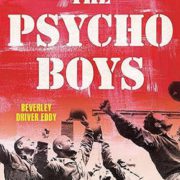The Psycho Boys – by Beverly Driver Eddy
By Sheldon Goldberg
On the edge of the Gettysburg Battlefield was a former camp known as CCC Gettysburg 2. Initially housing an all-black Civilian Conservation Corps unit, the camp was abandoned in1942 but converted to a small Army sub-camp of Camp Ritchie in 1943. Its purpose was somewhat given away by its name – Camp George H. Sharpe – named after General George G. Meade’s intelligence officer during the Battle of Gettysburg.
The initial cadre of about 60 men were those who had completed intelligence training at Camp Ritchie but were now receiving commando/ranger training before being deployed behind enemy lines in Europe. Following this group were approximately 800 soldiers, described as not being in the best physical shape, differing in age, and from a multitude of civilian occupations and professions. Many, but not all, were Jewish. Some were native-born Americans, others were immigrants and refugees from Europe who had managed to escape the Nazis. Some had received training at Camp Ritchie, many not. That said, several common threads bound them together: their language skills, their knowledge of Europe, and their desire to defeat the Axis.
At Camp Sharpe they would be divided into four Mobile Radio Broadcasting (MRB) companies and taught skills needed to interrogate prisoners and civilians, make radio broadcasts, loudspeaker appeals, leaflet and newspaper production, and operate both in front of and behind enemy lines. Trained in psychological warfare, these secret units would become known as “The Psycho Boys.”
The book itself, an updated and somewhat revised version of the author’s 2015 book, The Camp Sharpe Psycho Boys, is the result of a number of interviews with living members of these MRBs and in-depth research by the author. It tells us the previously unknown story of their participation in the war in Europe chronologically from their Camp Sharpe training to D-Day in Normandy to the surrender of Germany and beyond. It concludes in describing, often in the participants own words, the role they played, in and out of uniform, in the democratization of the erstwhile Nazified German population. In doing this, the author introduces us to a number of the Psycho Boys who were at one time academics, diamond cutters, meteorologists, writers, authors, and musicians. One was even a Disney artist while another was a prominent gossip columnist and yet another a Harvard University Literature professor.
All of them became students of Lieutenant Hans Habe, a Hungarian-born newspaperman who fought with the French Foreign Legion, was captured by the Germans and escaped before coming to America. Here, his exploits became a novel that became a Hollywood film. Beyond that, his proven skill at interrogating prisoners of war and writing effective propaganda pamphlets led him to become the trainer for all four MRB companies.
In each of the book’s nine chapters, which follows the progress of the U.S. forces from Normandy to the German homeland, the author provides a narrative, often in the soldiers’ own words of actions taken to conduct their mission which was, armed only with truth, to convince enemy soldiers to surrender, often at the cost of the MRB soldier’s life. These narratives, combined with photos of MRB soldiers, make for an interesting and easy reading experience.
For this reviewer, however, the last three chapters, “Confronting the Camps,” “Going “Home,” and “Working for a Democratic Germany,” are the most interesting. The author makes clear that as horrific as it was to enter the concentration camps without knowing beforehand of their existence, it was worse for the foreign-born MRB men, many of whom had family and friends among the survivors. The descriptions of what the MRB men found in the camp, and of the atrocities that took place, often only hours before the Americans arrived, remain even today difficult to read and comprehend. Several of the German-born MRB men who personally experienced Nazi brutality before escaping Germany, describe tours they gave to German locals who claimed innocence and not knowing despite their proximity to the camps. One MRB soldier said that they seemed “not to have had the slightest qualms about living in the smoke of the Nazi crematoria.”
Again, through the words of the author’s interviewees, we experience what it was like for some of the foreign-born MRB men to return to the cities in which they had lived, e.g., Leipzig, Augsburg, Nuremburg, and Berlin, were but a few. Lastly, she describes how many MRB men remained in Germany after the war to focus their efforts on denazification and re-education. The several different newspapers they produced in the German style became the biggest newspaper concern in the world with a circulation of over 8 million. Similarly, some reactivated radio stations while others culled the professional and cultural arenas, deciding who could continue in their professions and who were banned as a result of the Nazi affiliation.
Toward the end of the book, the author objectively makes clear that the efforts of many of these former MRB men were making to bring democracy to Germany ran counter to U.S. government policy. Initially, criticism of the Soviet Union was not allowed, but with the beginning of the Cold War, this began to change and despite the Nuremburg trials, the de-Nazification programs slowly ended.
The book concludes with brief descriptions of what a number of the MRB men did after leaving the Army or government service. She closes the book by writing “As paragraph troopers, who chose words over rifles or other weapons of choice, the psycho boys had fought to preserve ideals rather than extinguish lives.”
As one who served two tours in Post-war Germany, I saw the fruits of their labors.
Volume 77. Number 4. 2023




